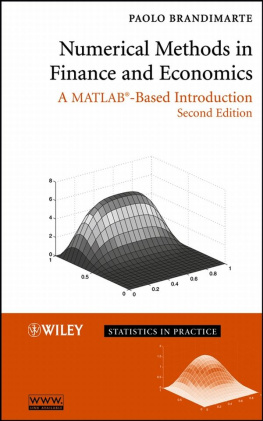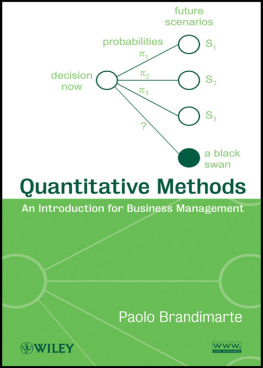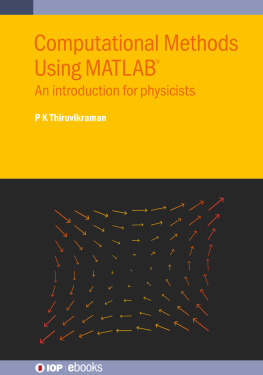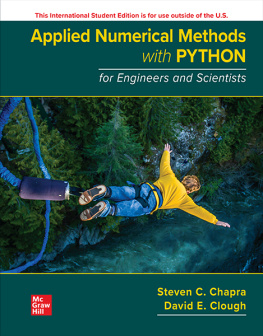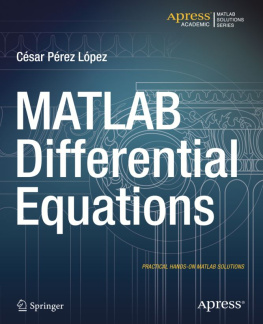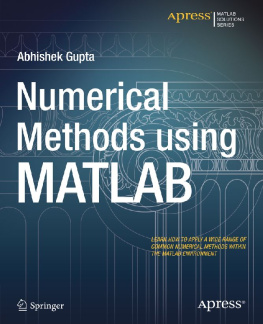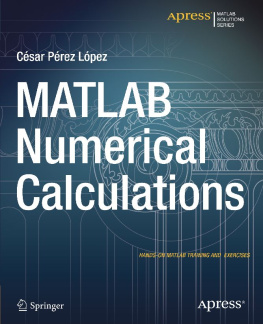Brandimarte - Numerical Methods in Finance and Economics 20: A MATLAB-Based Introduction
Here you can read online Brandimarte - Numerical Methods in Finance and Economics 20: A MATLAB-Based Introduction full text of the book (entire story) in english for free. Download pdf and epub, get meaning, cover and reviews about this ebook. year: 2013, publisher: Wiley, genre: Children. Description of the work, (preface) as well as reviews are available. Best literature library LitArk.com created for fans of good reading and offers a wide selection of genres:
Romance novel
Science fiction
Adventure
Detective
Science
History
Home and family
Prose
Art
Politics
Computer
Non-fiction
Religion
Business
Children
Humor
Choose a favorite category and find really read worthwhile books. Enjoy immersion in the world of imagination, feel the emotions of the characters or learn something new for yourself, make an fascinating discovery.
- Book:Numerical Methods in Finance and Economics 20: A MATLAB-Based Introduction
- Author:
- Publisher:Wiley
- Genre:
- Year:2013
- Rating:4 / 5
- Favourites:Add to favourites
- Your mark:
- 80
- 1
- 2
- 3
- 4
- 5
Numerical Methods in Finance and Economics 20: A MATLAB-Based Introduction: summary, description and annotation
We offer to read an annotation, description, summary or preface (depends on what the author of the book "Numerical Methods in Finance and Economics 20: A MATLAB-Based Introduction" wrote himself). If you haven't found the necessary information about the book — write in the comments, we will try to find it.
Numerical Methods in Finance and Economics 20: A MATLAB-Based Introduction — read online for free the complete book (whole text) full work
Below is the text of the book, divided by pages. System saving the place of the last page read, allows you to conveniently read the book "Numerical Methods in Finance and Economics 20: A MATLAB-Based Introduction" online for free, without having to search again every time where you left off. Put a bookmark, and you can go to the page where you finished reading at any time.
Font size:
Interval:
Bookmark:

STATISTICS IN PRACTICE
Advisory Editor
Peter Bloomfield
North Carolina State University, USA
Founding Editor
Vic Barnett
Nottingham Trent University, UK
Statistics in Practice is an important international series of texts which provide detailed coverage of statistical concepts, methods and worked case studies in specific fields of investigation and study.
With sound motivation and many worked practical examples, the books show in down-to-earth terms how to select and use an appropriate range of statistical techniques in a particular practical field within each titles special topic area.
The books provide statistical support for professionals and research workers across a range of employment fields and research environments. Subject areas covered include medicine and pharmaceutics; industry, finance and commerce; public services; the earth and environmental sciences, and so on.
The books also provide support to students studying statistical courses applied to the above areas. The demand for graduates to be equipped for the work environment has led to such courses becoming increasingly prevalent at universities and colleges.
It is our aim to present judiciously chosen and well-written workbooks to meet everyday practical needs. Feedback of views from readers will be most valuable to monitor the success of this aim.
A complete list of titles in this series appears at the end of the volume.

Copyright 2006 by John Wiley & Sons, Inc. All rights reserved.
Published by John Wiley & Sons, Inc., Hoboken, New Jersey.
Published simultaneously in Canada.
No part of this publication may be reproduced, stored in a retrieval system, or transmitted in any form or by any means, electronic, mechanical, photocopying, recording, scanning, or otherwise, except as permitted under Section 107 or 108 of the 1976 United States Copyright Act, without either the prior written permission of the Publisher, or authorization through payment of the appropriate per-copy fee to the Copyright Clearance Center, Inc., 222 Rosewood Drive, Danvers, MA 01923, (978) 750-8400, fax (978) 750-4470, or on the web at www.copyright.com . Requests to the Publisher for permission should be addressed to the Permissions Department, John Wiley & Sons, Inc., 111 River Street, Hoboken, NJ 07030, (201) 748-6011, fax (201) 748-6008, or online at http://www.wiley.com/go/permission .
Limit of Liability/Disclaimer of Warranty: While the publisher and author have used their best efforts in preparing this book, they make no representations or warranties with respect to the accuracy or completeness of the contents of this book and specifically disclaim any implied warranties of merchantability or fitness for a particular purpose. No warranty may be created or extended by sales representatives or written sales materials. The advice and strategies contained herein may not be suitable for your situation. You should consult with a professional where appropriate. Neither the publisher nor author shall be liable for any loss of profit or any other commercial damages, including but not limited to special, incidental, consequential, or other damages.
For general information on our other products and services or for technical support, please contact our Customer Care Department within the United States at (800) 762-2974, outside the United States at (317) 572-3993 or fax (317) 572-4002.
Wiley also publishes its books in a variety of electronic formats. Some content that appears in print may not be available in electronic format. For information about Wiley products, visit our web site at www.wiley.com .
Library of Congress Cataloging-in-Publication Data:
Brandimarte, Paolo.
Numerical methods in finance and economics : a MATLAB-based introduction / Paolo
Brandimarte.2nd ed.
p. cm.
Rev. ed. of: Numerical methods in finance. 2002.
Includes bibliographical references and index.
ISBN-13: 978-0-471-74503-7 (cloth)
ISBN-10: 0-471-74503-0 (cloth)
1. FinanceStatistical methods. 2. EconomicsStatistical methods. I. Brandimarte, Paolo.
Numerical methods in finance. II. Title.
HG176.5.B73 2006
332.0151dc22
2006045787
10 9 8 7 6 5 4 3 2 1
This book is dedicated to Commander Straker, Lieutenant Ellis, and all SHADO operatives. Thirty-five years ago they introduced me to the art of using both computers and gut feelings to make decisions.
Preface to the Second Edition
After the publication of the first edition of the book, about five years ago, I have received a fair number of messages from readers, both students and practitioners, around the world. The recurring keyword, and the most important thing to me, was useful. The book had, and has, no ambition of being a very advanced research book. The basic motivation behind this second edition is the same behind the first one: providing the newcomer with an easy, but solid, entry point to computational finance, without too much sophisticated mathematics and avoiding the burden of difficult C++ code, also covering relatively non-standard optimization topics such as stochastic and integer programming. See also the excerpt from the preface to the first edition. However, there are a few new things here:
- a slightly revised title;
- completely revised organization of chapters;
- significantly increased number of pages.
The title mentions both Finance and Economics, rather than just Finance. To avoid any misunderstanding, it should be made quite clear that this is essentially a book for students and practitioners working in Finance. Nevertheless, it can be useful to Ph.D. students in Economics as well, as a complement to more specific and advanced textbooks. In the last four years, I have been giving a course on numerical methods within a Ph.D. program in Economics, and I typically use other available excellent textbooks covering advanced algorithms which can be used to solve a wide array of problems in Economics. From the point of view of my students in such a course, the present book has many deficiencies: For instance, it does not cover ordinary differential equations and it does not deal with computing equilibria or rational expectations models; furthermore, practically all of the examples deal with option pricing or portfolio management. Nevertheless, given my experience, I believe that they can benefit from a more detailed and elementary treatment of the basics, supported by simple examples. Moreover, I believe that students in Economics should also get at least acquainted with topics from Operations Research, such as stochastic programming and integer programming. Hence, the and Economics part of the title suggests potential use of the book as a complement, and by no means as a substitute.
The book has been reorganized in order to ease its use within standard courses on numerical methods for financial engineering. In the first edition, optimization applications were dealt with extensively, in chapters preceding those related to option pricing. This was a result of my personal background, which is mainly Computer Science and Operations Research, but it did not fit very well with the common use of a book on computational finance. In the present edition, advanced optimization applications are left to the last chapters, so they do not get into the way of most financial engineering students. The book consists of twelve chapters and three appendices.
Next pageFont size:
Interval:
Bookmark:
Similar books «Numerical Methods in Finance and Economics 20: A MATLAB-Based Introduction»
Look at similar books to Numerical Methods in Finance and Economics 20: A MATLAB-Based Introduction. We have selected literature similar in name and meaning in the hope of providing readers with more options to find new, interesting, not yet read works.
Discussion, reviews of the book Numerical Methods in Finance and Economics 20: A MATLAB-Based Introduction and just readers' own opinions. Leave your comments, write what you think about the work, its meaning or the main characters. Specify what exactly you liked and what you didn't like, and why you think so.

